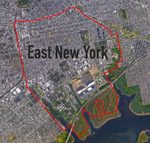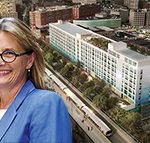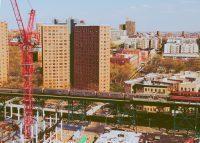A Brooklyn firm that excels at construction, not politics, is nonetheless cruising through the fraught rezoning process to erect a new headquarters in Gowanus.
The key reason: The favor it’s seeking is to exclude the 270 parking spots that the current zoning would require.
Monadnock Construction this week asked the City Planning Commission to let it build a 100,000-square-foot, mixed-use development at 300 Huntington Street, beside the neighborhood’s namesake canal. A decision is pending, after which the company will need the City Council to sign off as well, but no one seems too worried about the exemption it is seeking.
That’s because in progressive community districts, dropping the parking requirement is seen as a benefit.
“We’ve had a lot of these debates, and usually the fears of too much traffic and not enough parking never materialize. We’ve learned from experience,” said Doug Gordon, a safe-streets advocate and public member of Community Board 6’s transportation committee. “Ninety-nine percent of the time, when the project actually goes in, all the things people were afraid of happening never happen.”
Read more



Monadnock’s application flew through the community board, receiving unanimous approval — an advisory opinion that carries weight with local City Council member Brad Lander, who will ultimately decide the project’s fate.
But Lander is not likely to need much convincing that 270 parking spots are not needed. The project site is steps from the Smith-9th Street subway station, and Lander is a progressive familiar with the concept of induced demand.
“There’s an adage that parking is a fertility drug for driving,” Gordon explained. “If you provide parking, people are going to drive, and if you don’t provide parking, they won’t.”
With a massive cleanup of the notoriously noxious canal underway, the Monadnock project will include an esplanade, an amenity that greases the chains of approval in a neighborhood where development is often unwelcome. A broader rezoning, for which Lander is negotiating terms with the de Blasio administration, has stirred up vociferous opposition from some locals.
The esplanade will provide public access to a mile-long walkway beside the polluted canal. Plans to dredge it were delayed for years in part because the sediment — dubbed “black mayonnaise” — was so toxic that disposing of it proved problematic. It was just left at the canal’s bottom, along with abandoned cars and probably some corpses with concrete footwear.
Eventually the canal was declared a federal Superfund site, which the Bloomberg administration once predicted would scare off developers for years to come. But their interest in the gritty, low-lying area between Park Slope and Carroll Gardens has only picked up since the 2010 designation.
Monadnock’s plan calls for office, light industrial and street-level retail space, along with a construction yard. The site is in an industrial business zone, or IBZ, which signals that rezoning for residential use will not be granted. The firm is participating in the state’s brownfield program.
The new building, which could be ready in 2023, will serve as Monadnock’s headquarters. Some of the office space is likely to go to local groups viewed favorably by the community, further clearing the political path for the company. For good measure, Monadnock is throwing in bike parking, a green roof and canal-side plantings.
The manufacturing rezoning it has requested, from M2-1 to M2-3, would eliminate the parking requirement but not increase the size of the building. The property is in a “flood hazard area,” so below-grade parking is not feasible, and according to Monadnock, an above-ground garage would preclude development of the building with a construction yard.
